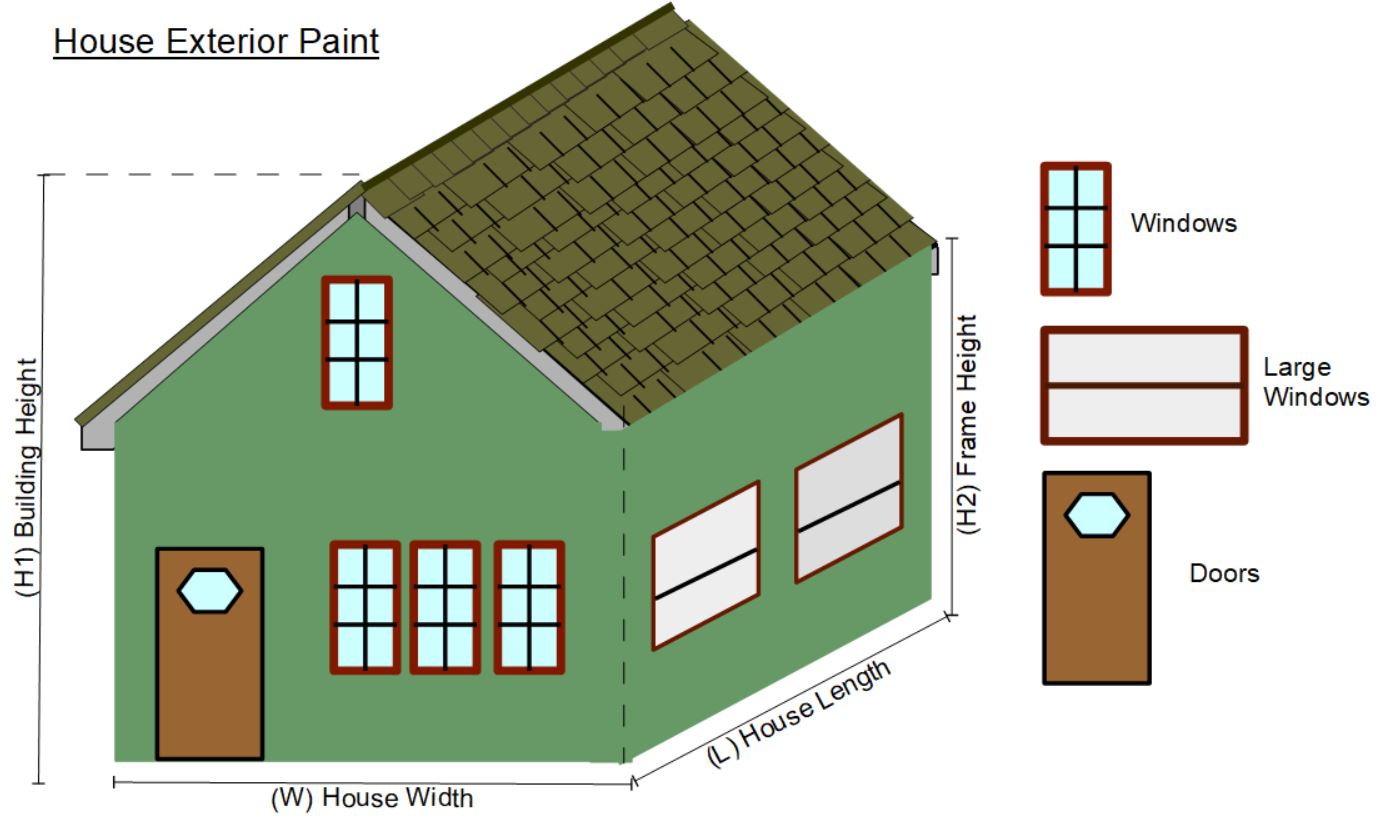Paint Calculator
Paint Calculators
- Paint for a Room: Computes the number of gallons of paint or primer
needed to paint an entire room, the four walls and ceiling and also for just the walls.
- Room Paint Cost: Estimates the cost of paint or primer needed to cover a rectangular room (blue in diagram) based on the length, width and height of the room.
- Paint for a Wall: Computes the number of gallons of paint or primer needed to paint a wall or any rectangular area (wall or ceiling).
- Cost to Paint a Wall: Estimates the cost of paint or primer needed to cover a wall or other area defined by a length and a height or width.

- Ceiling Paint Cost: Estimates the cost of paint or primer needed to cover a ceiling of a rectangular room based on the length and width of the room.
- Exterior Paint for a House: Computes the number of gallons of exterior paint for a gabled building like a common house based on the dimensions, number of large and small windows, number of doors and the number of coats of paint
- Wood Stain Calculator: Computes the amount of wood stain to finish wood surfaces based on a length, width and the stain product coverage defined by a container size and coverage per container.
- Deck Stain and Sealer: Computes the number of quarts of stain and sealer needed for a deck based on the size and whether rough or smooth.
- Paint for Pipes: Computes the amount of paint needed to cover the exterior surface area of one or more pipes based on the pipe diameter, length, number of coats, number of pipes and the recommended area coverage of the paint.
- Paint for Corrugated Surfaces: Computes the amount of paint needed for a corrugated surface based on the dimensions of the corrugated surface area (length and width), a corrugation factor, coverage per gallon of paint used and the number of coats of paint.
- Paint for Gambrel Wall:
Computes the gallons of paint needed to cover a wall under a gambrel shaped roof.
- Paint Pricing Survey: Dataset containing a history of periodic pricing for paint products including primer and three price points (economy, medium and premium) paint. Data comes from nationally advertised prices on the website of national retailers.
- Barn Paint Calc: Computes the amount of paint needed for the surface area of a barn (not the roof) including the sides under a gambrel roof and the sides. This is based on the barn's span, length, total height, and height and width of the loft and coverage of the barn paint.
| Benjamin Moore | Behr | Valspar |
| Magnolia Home | Glidden | Olympic |
| Clark + Kensington | Pittsburgh Paint | RUST-OLEUM |
INTERIOR PAINT: The formulas estimates the amount of paint needed for individual walls, all the walls within a room (royal blue in diagram) and a ceiling (light blue in diagram). Each formula calculates the area to be painted based on the dimensions entered, and then estimates the amount of paint or primer needed for this area. A gallon of good paint typically covers 400 ft2. A gallon of primer typically covers 200 ft2..
EXTERIOR PAINT: The formula estimates the paintable surface area of a simple house (gabled). It computes the exterior square footage and reduces the amount by a factor of the number of doors and windows. Exterior paint is usually recommended to cover 300 ft2 per gallon.
Paint Pricing Survey Data
Always use use local pricing for paint or primer since prices and availability will vary. However, the following prices are recent U.S. dollar costs for one gallon of paint or primer in the United States:
- Paint Pricing Survey date: 1/30/25
- Paint Price Survey Source (online): Menards
- Price of premium (high quality) paint: $118.0 USD
- Price of medium grade paint: $50.98 USD
- Price of economy paint: $15.99 USD
- Price of primer: $14.98 USD
Painting Guidance
- How much paint to do you need? The calculators on this page will help you compute the amount of paint you will need for the walls and ceiling. However, you will also need paint for the trim (baseboards, crown molding, chair rails) and for door framing.
- How do you want the paint to appear? Color is your first major choice, but then you also have to consider the sheen. The most common are flat, eggshell, satin, semi-gloss and high gloss. Semi-gloss and high-gloss are often used in high traffic areas and are more durable for cleaning.
- Preparing the paint area.
- Obviously you want to clear the area and move items that might get in the way or be damaged if dripped with paint.
- Use drop cloths to protect items and reduce cleanup work.
- Remove items that can be easily removed to reduce trim work. This includes outlet covers, light switches and vent covers.
- Surface preparation is important.
- If you're covering a stain, you'll want a product Kilz to stop the stain from going through the new paint.
- If you're covering drywall or large patches, you'll want the drywall be be smooth with patches and seams that are spackled and sanded and you'll want to remove the spackle dust with a rag or tacky cloth.
- In all cases, scrape away old paint that is pealing.
- Apply caulking around door frames, windows and moldings.
- Apply painters tape on edges to protect them from paint
- Paint from the top down. Start with ceilings and then walls. Once these have dried, then paint windows, doors and trim. Walls and ceilings are often painted with rollers or spray guns. Trim work is most commonly done with smaller brushes.
- Final Touches: After the paint has dried, slowly remove masking tape to prevent paint from pealing away with the tape. Return all removed fixtures.
- Clean Up: Soap and water is enough for non-oil based paints. Wash the brushes, rollers and rolling pans. For oil-based paints, follow the manufactures guidance on the paint cans. Retain the old paint for touchups in the future if possible. Otherwise recycle when possible.
Equations
- Paint for a Room KurtHeckman Use Equation
- Room Paint Cost KurtHeckman Use Equation
- Paint for a Wall KurtHeckman Use Equation
- Cost to Paint a Wall KurtHeckman Use Equation
- Ceiling Paint Cost KurtHeckman Use Equation
- Exterior Paint for House KurtHeckman Use Equation
- Wood Stain over Length by Width KurtHeckman Use Equation
- Deck Stain and Sealer KurtHeckman Use Equation
- Paint for Pipes KurtHeckman Use Equation
- Paint for Corrugated Surfaces KurtHeckman Use Equation
- Paint for Gambrel Wall KurtHeckman Use Equation
- Barn Paint Calc KurtHeckman Use Equation
Data Items
- Paint Cost (Observation Date) KurtHeckman Use Data Item
- Paint Cost (Store) KurtHeckman Use Data Item
- Paint Cost (High Grade) KurtHeckman Use Data Item
- Paint Cost (Mid Grade) KurtHeckman Use Data Item
- Paint Cost (Economy) KurtHeckman Use Data Item
- Paint Cost (Primer) KurtHeckman Use Data Item
Datasets
- Comments
- Attachments
- Stats
No comments |

